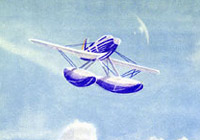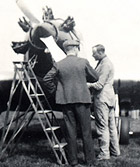"George instantly had the plane 45 degrees nose down to maintain speed in a glide, lowered the undercarriage, made a 180-degree turn, and made a perfect landing back on the runway downwind"
Home leave in 1931 which had promised so much to Hope and Archie out in the 'Bush', lived up to expectations.... George Stainforth had rejoined the High Speed Flight preparing for the Schneider Trophy contest that September, and they had rented a bungalow close by Calshot Seaplane Base for six weeks until the end of August so that they could watch George practising, and be present at the Race itself. Italians, French and Americans were expected to take part, so it would be exciting....
... Archie bought an Austin saloon car for £5, was given an open pass into the seaplane base, and the three of them [Archie, Hope and Peter] spent every flying day (of which there were many during July and August) watching the British team prepare. Security was fairly lax, and civilians were allowed to wander round the station, even being escorted round the hangars. George, having no children of his own took a special interest in Peter, and sat him in the cockpit of one of the new Supermarine S6B racers. Peter was in a Seventh Heaven.
Sadly the race itself never materialised. The French were unable to develop a satisfactory engine for their machine; the Italian revolutionary twin engined plane with contra-rotating propellers crashed, killing their leading pilot; and the Americans withdrew at the beginning of the year. Our team, as well, had had financial difficulties, and might have pulled out, had it not been for a wealthy sponsor, Lady Houston, coming forward with £100,000 which enabled two S6B planes and three Rolls Royce engines to be produced. So the race was to be a 'fly-round' in order for Great Britain to complete the hat-trick of three wins and retain the Trophy outright. Flight Lieutenant Boothman was chosen to fly the course and 'win' the race; George Stainforth, the veteran pilot from the 1929 team, was chosen to have a crack at breaking the World Air Speed record.

Although something of an anti-climax, Boothman raised the course record to 340 m.p.h., while George broke the speed record by over 50 m.p.h., achieving an average speed over four runs in opposite directions of 407.5 m.p.h. on 29th September. For his fine performance, George was awarded the Air Force Cross and posted to Farnborough, the R.A.F. Experimental Station, for two years to continue test flying the new generation of aircraft coming into use.
*****
During George's three-year tour of duty at the Royal Aircraft Establishment at Farnborough as a test pilot, he was approached by Mr. Nevil Shute Norway, the founder of an infant aeroplane company, Airspeed, to test fly their new small commercial monoplane, the Courier. Norway, who had been the chief designer on the R100 airship project and, when that enterprise folded after the disaster to the rival R101, had decided to set up his own company at Portsmouth with two or three enthusiasts and with the backing of Lord Grimthorpe. Nevertheless, the new company was operating on a shoe-string with a minimum of working capital, and they had sunk every last penny in this brilliant new machine, the first plane ever to have a retractable undercarriage.
Norway could not afford to pay the high fee demanded by the well-known test pilots of the day, and had picked George on account of his reputation and because, in common with other impecunious married Flight Lieutenants, he might be prepared to accept the very small fee that they were able to offer. The Royal Air Force made no objection to George accepting the job, and he took the train down to Airspeed's factory at Portsmouth at the beginning of April 1933.
For the whole of his first day at Airspeed, George spent sitting in the cockpit of the Courier, raised on trestles in the hangar, going over and over the controls with the chief inspector by his side, asking the same questions in an apparent daydream, much to Norway's exasperation. George was far from being slow witted, but this was his way of memorising every detail, so in the event of an emergency his reaction would be instantaneous and effective.

Sure enough, George's pre-flight preparation paid off. On the plane's first flight, taking off into an easterly wind from Portsmouth aerodrome, the engine cut out completely at about 200 ft. Ahead lay the mudflats and tidal waters of Langstone Harbour. To make an orthodox emergency landing dead ahead would have resulted in considerable damage or a complete write-off of the machine in which Airspeed had gambled their fortunes and future. Instead, with the machine still climbing, George instantly had the plane forty-five degrees nose down to maintain speed in a glide, lowered the undercarriage, made a one hundred and eighty degree turn, and made a perfect landing back on the runway downwind. It was one of the most outstanding feats of airmanship that Norway, writing under his pen-name Nevil Shute, in his book 'Slide Rule', had ever witnessed.
George spent three weeks with Airspeed flight-testing the Courier, which then went on to become a commercial success. The design of its retractable undercarriage, too, became incorporated in the specification for the new generation of fighter planes, the Hurricane and Spitfire, of Battle of Britain fame.
Not Found Wanting, pp.385-6, 389